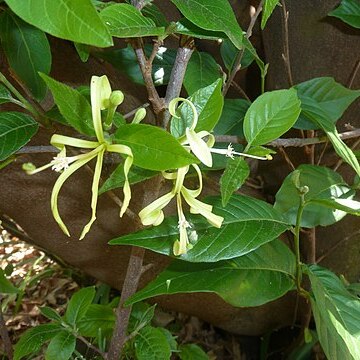Deciduous shrub or small tree up to 9 m tall, sometimes scrambling. Leaves ovate to lanceolate. Inflorescence a 2-10-flowered fascicle terminating short bracteate shoots behind the current year's growth, rarely in the leaf axils. Flowers appearing before or with the new leaves, strongly scented at night. Petals 35-60 x 3 mm, pale green, turning pale yellow. Staminal tube pure white. Ovary 10-locular, puberulous. Capsule leathery, becoming woody, obovoid, 15 mm in diameter, deeply sulcate and transversely ribbed. Seeds 6 mm long; testa bright orange, contrasting with the whitish, fleshy aril which covers c. one third of the seed.
Deciduous shrub or small tree, 1-9 m high. Leaves ovate, up to 140 mm long, setulose especially on nerves beneath, apex acuminate. Flowers in 2-10-flowered fascicles, terminating short-shoots, appearing before leaves, scented. Petals narrowed into a long claw, pale green turning pale yellow. Staminal tube pure white, widening upwards; tube 10-toothed; anthers shortly apiculate. Ovary 10-locular, style exserted, bent at apex, style head depressed globose. Flowering time Sept.-Mar. Fruit a 10-or 12-valved capsule, thickly woody. Seeds 2 in each locule, red or black, subglobose with ± conspicuous orange, red or whitish aril.
Leaf-lamina up to 14 × 7 cm., ovate to lanceolate, densely setose when young, more sparsely so later, except on nerves beneath, apex acuminate, base subtruncate, rounded or broadly cuneate; petiole up to 1·5 cm. long.
A shrub or small tree. It can grow 15 m high. It loses its leaves during the year. The leaf blades are 14 cm long by 7 cm wide. They are oval. The fruit is a capsule 1-2.5 cm across and round or oval.
Staminal tube (2·5) 3·6–4·5 cm. long, pure white, cylindric, glabrous inside; appendages in pairs alternating with the anthers, 3 mm. long, glabrous outside.
Deciduous shrub or small tree up to 10 (13) m. tall, sometimes scrambling; first-year branchlets shortly pubescent, second-year purple-brown and glabrous.
Capsule 1·3–2·4 × 2 cm., obovoid-cylindric, globose or depressed-globose, deeply ribbed and sulcate, woody, glabrous; aril covering about half of seed.
Inflorescence a 2–7-flowered false raceme or flowers subfasciculate; peduncle 3–8 mm. long; bracts 2 mm. long, squamiform; pedicels 5–17 mm. long.
Petals (3·8) 4·5–5·2 × 0·3 cm., greenish-white, linear-spathulate, sparsely puberulous outside.
Ovary 10-locular, puberulous; style (4) 4·8–5·5 cm. long; style-head globose.
Calyx 2·5–5 mm. long, densely puberulous to tomentellous.


